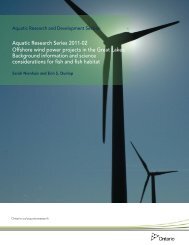Ontario's Natural Heritage Areas - Ministry of Natural Resources
Ontario's Natural Heritage Areas - Ministry of Natural Resources
Ontario's Natural Heritage Areas - Ministry of Natural Resources
You also want an ePaper? Increase the reach of your titles
YUMPU automatically turns print PDFs into web optimized ePapers that Google loves.
5. National Designations and Mechanisms<br />
Introduction<br />
Throughout Canada a number <strong>of</strong> national<br />
designations serve to protect natural and cultural<br />
heritage areas and values. Nine <strong>of</strong> these national<br />
designations are relevant to Ontario:<br />
• National Parks.<br />
• National Marine Conservation <strong>Areas</strong>.<br />
• National Historic Sites.<br />
• Canadian <strong>Heritage</strong> Rivers.<br />
• Migratory Bird Sanctuaries.<br />
• National Wildlife <strong>Areas</strong>.<br />
• Oceans Act Marine Protected <strong>Areas</strong>.<br />
• Marine Wildlife <strong>Areas</strong>.<br />
• National Capital Commission Lands.<br />
5.1 National Parks<br />
Introduction<br />
Canada’s National Parks program was formally<br />
initiated in 1885 with the protection <strong>of</strong> the Banff<br />
mineral hot springs (Parks Canada, 1997). National<br />
Parks protect ecosystems that represent Canada’s<br />
natural heritage for the benefit <strong>of</strong> present and future<br />
generations. Parks Canada strives to maintain the<br />
integrity <strong>of</strong> ecosystems in each park while providing<br />
opportunities for public enjoyment and education.<br />
The National Parks program is designed to protect<br />
‘representative areas’ in each <strong>of</strong> Canada’s 39<br />
terrestrial natural regions (Parks Canada, 1994:24,<br />
1997). Although a representative park has not yet<br />
been established in every natural region, 43 National<br />
Parks have been created. In Ontario, five National<br />
Parks have been established in three <strong>of</strong> seven natural<br />
regions (Parks Canada, 1997) (Table 5-1, Fig. 5-1).<br />
The 1971 version <strong>of</strong> the National Parks System<br />
Planning Manual provided the first comprehensive<br />
management framework for establishing a system<br />
<strong>of</strong> parks across Canada (Parks Canada, 1971). It was<br />
subsequently updated in 1979 and 1994 during<br />
Table 5-1. National Parks in Ontario.<br />
Image by P. Kor<br />
National Park<br />
Year<br />
Established Area (ha)<br />
St. Lawrence Islands National Park 1914 870<br />
Point Pelee National Park 1918 1,500<br />
Georgian Bay Islands National Park 1929 2,560<br />
Pukaskwa National Park 1971/78 187,800<br />
Bruce Peninsula National Park 1987 15,400<br />
Sources: Parks Canada (1997) and MNR (2006a).<br />
Total 208,130<br />
which time National Parks policy and planning<br />
evolved significantly (Parks Canada, 1979, 1994). For<br />
example, the 1994 policy improves upon the 1979<br />
policy by providing more scope for collaborative work<br />
outside park boundaries with managers responsible<br />
for adjacent lands and waters in recognition that<br />
ecosystem boundaries <strong>of</strong>ten extend beyond the park.<br />
115 Ontario’s <strong>Natural</strong> <strong>Heritage</strong> <strong>Areas</strong>

















